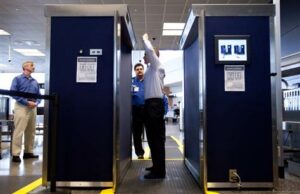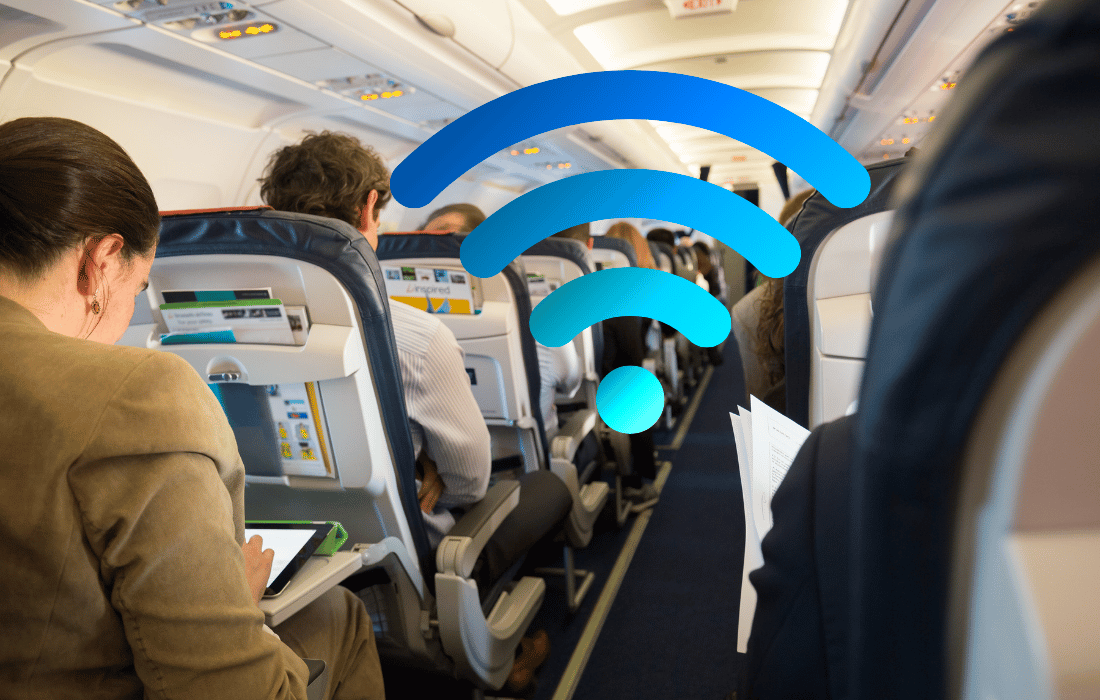For athletes, frequent air travel is often a necessary part of the job, whether for competitions, training camps, or promotional events. However, the convenience of flying comes with a less obvious risk—exposure to electromagnetic fields (EMFs). EMFs are emitted by various electronic devices and systems throughout the flight experience, from airport security scanners to in-flight Wi-Fi. Understanding the potential health implications of EMF exposure and adopting strategies to minimize it can help athletes maintain peak performance and overall well-being. Here, we will analyze the sources of EMFs during air travel, including the cockpit, cabin, and airport facilities, and provide practical solutions for athletes to protect themselves.
EMF Exposure in the Cockpit and Aircraft Cabin

The study “Impact of Cockpit Electro-Magnetics on Aircrew Neurology (ICEMAN)” conducted by Dr. Dan “Animal” Javorsek reveals significant concerns about EMF exposure in aircraft cockpits. The study highlights that pilots are exposed to various EMFs from onboard systems, such as communication links, navigation equipment, and tactical audio headsets. These EMFs can potentially affect cognitive performance, leading to symptoms like task saturation, misprioritization, and spatial disorientation. Notably, from 1993 to 2013, spatial disorientation was linked to 72 Class A mishaps in the US Air Force, resulting in 101 fatalities and the loss of 65 aircraft. The ICEMAN study aims to measure these fields and their impacts, with the ultimate goal of developing mitigation strategies to enhance pilot safety and performance.
In addition to the cockpit, the entire aircraft cabin is subject to EMF exposure. The “5G Spatial Modeling of Personal RF-EMF Assessment Within Aircrafts Cabin Environments” study explores the effects of newer 5G technologies within aircraft. It reveals that EMF levels can vary based on aircraft design, the number of active devices, and the flight phase. During critical times like boarding and disembarking, when passengers are most likely to use their devices, the cabin can become saturated with EMFs. While these levels generally do not exceed international safety limits, cumulative exposure, especially for frequent flyers like athletes, remains a concern.
Airport EMFs: From Check-in to Boarding
 Athletes encounter EMFs as soon as they enter the airport. Security procedures, in particular, can be a significant source of exposure. Full-body scanners, commonly used at security checkpoints, emit EMFs as they scan passengers. These scanners use either millimeter-wave technology or backscatter X-ray technology. Although the radiation dose is typically low, frequent exposure can add up over time. For those concerned about cumulative exposure, opting for a manual pat-down instead of a full-body scan can be a safer alternative. This choice, while more time-consuming, significantly reduces exposure to ionizing radiation.
Athletes encounter EMFs as soon as they enter the airport. Security procedures, in particular, can be a significant source of exposure. Full-body scanners, commonly used at security checkpoints, emit EMFs as they scan passengers. These scanners use either millimeter-wave technology or backscatter X-ray technology. Although the radiation dose is typically low, frequent exposure can add up over time. For those concerned about cumulative exposure, opting for a manual pat-down instead of a full-body scan can be a safer alternative. This choice, while more time-consuming, significantly reduces exposure to ionizing radiation.
Beyond security, the airport environment is saturated with EMFs from various sources, including Wi-Fi networks, communication systems, and electronic displays. These systems contribute to the overall EMF environment, creating a web of invisible waves that passengers and airport staff alike are exposed to. The combination of airport EMFs and those experienced during the flight can result in significant cumulative exposure, particularly for frequent travelers.
EMF Exposure During the Flight
Once aboard, passengers continue to be exposed to EMFs from various sources. The cabin environment includes in-flight Wi-Fi, entertainment systems, and passengers’ personal devices. The 5G study mentioned earlier demonstrated that EMF exposure could increase with the number of active devices, particularly when many passengers are using high-frequency connections simultaneously. The implementation of 5G technology, with its higher frequency bands, raises additional concerns as these waves can penetrate the body more deeply than those from previous wireless generations.
Furthermore, during flights, EMFs are not only emitted by passengers’ devices but also by the aircraft’s own communication and navigation systems. For athletes, who may travel frequently and spend extended periods in the air, this exposure is a growing concern. The effects of prolonged exposure to low-level EMFs can lead to oxidative stress, a state where free radicals outnumber antioxidants in the body, potentially causing cellular damage and increasing the risk of chronic health issues.
Practical Solutions for Athletes
Given the unavoidable nature of EMF exposure during air travel, athletes can take several steps to mitigate their risks:

Aires Tech customer with Lifetune Zone Max at the airport. Save 25% with code “MOL” Use of Aires Tech Products: Aires Tech offers a range of products designed to harmonize and neutralize harmful EMF frequencies. Their devices, such as the Aires Tech Lifetune Go and Aires Lifetune Flex, can be used on personal electronics to reduce exposure. These portable devices are easy to carry and can provide continuous protection throughout the flight.
Grounding Post-Flight: Grounding, or earthing, involves direct physical contact with the Earth, helping to neutralize free radicals and restore the body’s natural electrical balance. After a flight, athletes can benefit from grounding techniques, such as walking barefoot on natural surfaces like grass or sand. This practice can alleviate some of the physiological effects of EMF exposure and help reduce jet lag.
Nutritional Support: A diet rich in antioxidants can help combat the oxidative stress caused by EMFs. Antioxidants, found in foods like berries, Russet potatos, and avocados, neutralize free radicals. Omega-3 fatty acids, present in fish and flaxseeds, have anti-inflammatory properties that support the body’s defenses. Athletes should maintain a nutrition protocol that emphasizes these nutrients to mitigate the effects of EMF exposure.
Opt-Out of X-ray Scanners: To minimize exposure to ionizing radiation, athletes can opt out of full-body X-ray scanners at airport security and request a manual pat-down instead. This choice, while potentially more time-consuming, significantly reduces radiation exposure, which can be especially beneficial for frequent flyers.
Limiting Device Use: Athletes can reduce their EMF exposure during flights by limiting the use of electronic devices. Keeping devices in airplane mode, turning off Wi-Fi and Bluetooth, and using wired headphones instead of wireless options can all decrease exposure. Storing devices in bags rather than keeping them on the body also helps.
Choosing Seat Locations: The location of seats can impact EMF exposure levels. For instance, seats near the aircraft’s antennae or electronic equipment may have higher EMF levels. While it may not always be possible to choose a seat, understanding these factors can help athletes make informed decisions when booking flights.
Understanding the Impact of EMFs on Athletic Performance
EMF exposure can affect various aspects of an athlete’s performance, from sleep quality to recovery times. One critical area is the disruption of circadian rhythms. EMFs, especially those from electronic devices, can suppress melatonin production, a hormone crucial for regulating sleep. Poor sleep quality can impair recovery, reduce cognitive function, and decrease overall performance.
Oxidative stress is another concern. This condition, characterized by an imbalance between free radicals and antioxidants, can lead to cellular damage. For athletes, oxidative stress can impair muscle recovery, increase the risk of injuries, and exacerbate inflammation. Maintaining a diet rich in antioxidants and omega-3 fatty acids can help counteract these effects and support overall health.
Mitigating EMF Exposure Beyond the Flight
Athletes can take additional steps beyond the flight to mitigate EMF exposure. This includes being mindful of EMF sources in hotels, such as Wi-Fi routers and electronic devices, and minimizing their use. Using wired internet connections instead of Wi-Fi, turning off electronic devices when not in use, and avoiding unnecessary use of mobile phones can all help reduce exposure. Additionally, incorporating regular grounding practices, such as walking barefoot outdoors, can help maintain the body’s natural electrical balance.
These lifestyle practices are essential for an athlete to combat negative impact of EMFs, but Aires Tech products are a must for any serious competitor to recover properly and avoid oxidative stress.
Conclusion: Navigating EMF Exposure in Air Travel
As technology continues to advance, the prevalence of EMFs in daily life, including air travel, will likely increase. For athletes, understanding and mitigating the potential health risks associated with EMF exposure is crucial for maintaining optimal performance and overall well-being. By being proactive and adopting protective measures, such as using Aires Tech products, grounding, and maintaining a nutrient-rich diet, athletes can navigate the challenges of frequent flying with confidence.
Staying informed about the latest research on EMFs and their effects, such as the findings from the ICEMAN study and the 5G Spatial Modeling study, can help athletes make informed decisions. As we continue to explore the health implications of EMF exposure, prioritizing well-being and implementing practical strategies will be key to ensuring athletes perform at their best while safeguarding their long-term health.








